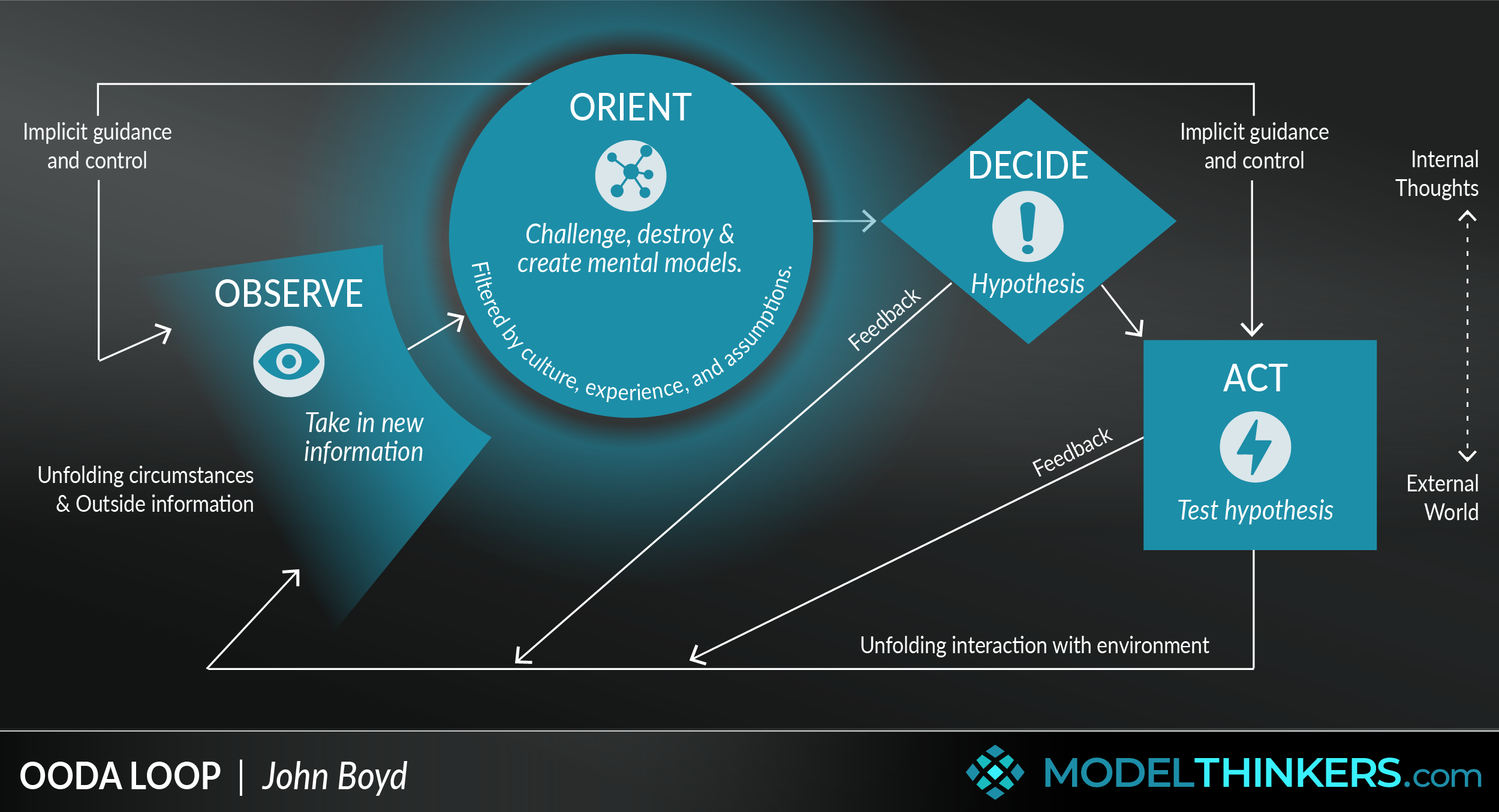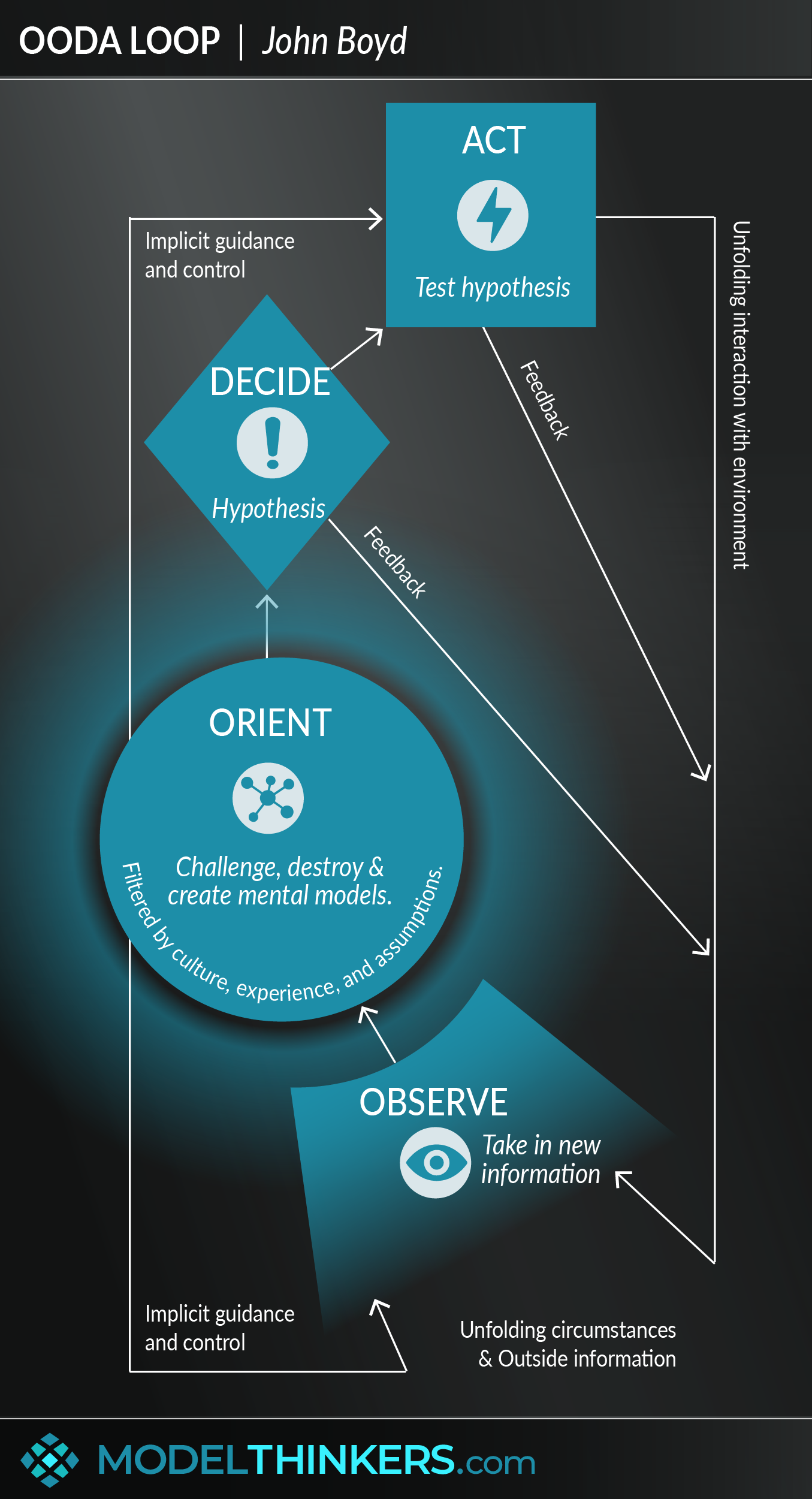

 0 saved
0 saved
 12.7K views
12.7K views








Inspired by the Scientific Method and created by one of the most effective fighter pilots in the history of warfare, this decision-making model is a go-to approach in competitive, conflict and/or volatile landscapes. When you dig beneath the superficial, it can improve the way you think and act in all aspects of your work and life.
The OODA Loop is a nonlinear and iterative decision-making process that involves dynamically observing, orienting, deciding, and acting.
BREAKING DOWN OODA.
This framework is particularly relevant in competitive or high-stakes environments where agility and response to changing circumstances are crucial. Here are the four elements in more detail: :
|
Stage |
Challenges |
Tips |
|
Observe. Take in new information and data about the environment and unfolding events. |
|
|
|
Orientation Challenge, destroy and create mental models as required to gain a more accurate understanding of what’s happening and what’s possible. It includes filters defined by culture and experience. |
|
|
|
Decide. Select a hypothesis to take action on. |
|
|
|
Act. Test your hypothesis in action. |
|
|
A NON-LINEAR PROCESS.
You might have seen those cycle diagrams to represent the OODA loop, working through each step in a staged process. Forget them. The strength of this approach lies in viewing it as a dynamic framework.
For example, Boyd pointed to the centrality of Orientation in the OODA Loop, explaining that “Orientation isn’t just a state you’re in; it’s a process. You’re always orienting.” This process of Orientation is about rapidly constructing, challenging, and destroying the mental models (Boyd called them 'mental concepts') in your head so you can understand and take action as effectively as possible.
Boyd explained: “We gotta get an image or picture in our head, which we call orientation. Then we have to make a decision as to what we’re going to do, and then implement the decision. . . . Then we look at the action, plus our observation, and we drag in new data, new orientation, new decision, new action, ad infinitum.”
SPEED & UNPREDICTABILITY IN COMPETITIVE ENVIRONMENTS.
It should come as no surprise that a model born from a fighter pilot has particular relevance in competitive environments. Indeed, one of Boyd’s big tips was to speed up your OODA Loop cycle to ‘get inside’ the OODA Loop of your opposition. Moving faster, and taking action that your opposition is not expecting, to disrupt their OODA Loop and challenge their mental models, forcing them to reorient and adapt to you.
WORKING IN COMPLEXITY.
Not in an explicitly competitive situation? The OODA Loop still applies and is particularly useful in complex, ambiguous environments. Proponents will argue that the OODA Loop is the process everyone uses, consciously or unconsciously, to understand and act in the world all the time.
The point then is to bring a more deliberate approach to make your OODA Loop more effective and faster. Concretely, some ways to improve your OODA Loop include:
- [Observe] Be present and open: work to access and be more sensitive to new information, particularly if it contradicts your current assumptions;
- [Orientate] Be prepared: work through multiple mental scenarios as you establish more accurate and dynamic mental models of a situation;
- [Decision] Be humble: view decisions as hypotheses to be tested rather than final commitments;
- [Act] Remain adaptable: frame your action as a way of generating valuable feedback, and be prepared to pivot and change as you learn more or the situation changes.
IN YOUR LATTICEWORK.
There are many links to be made with the OODA Loop. The process of generating and testing hypotheses is born from the Scientific Method and bears much resemblance to Double Loop Learning. The deconstruction and construction of mental models is strengthened by an understanding of Munger’s Latticework and the Map versus Territory models.
OODA Loop is a more dynamic and versatile decision-making approach than Decision Trees and Cost-Benefit Analysis, though consider how you might combine rather counterpose such models.
Finally, many devotees of David Snowden's Cynefin Framework have found interesting interplays between OODA and Cynefin, applying the OODA Loop differently in various Cynefin domains for greatest effectiveness — see the Origins & Resources section below for more including to a link by Dave Snowden on the topic.




-
Observe.
Develop the ability to take in multiple sources of information and data in any situation, not fixating on the obvious alone, and taking a detached, open interpretation of what is unfolding and the environment you are in.
-
Oriente.
Bring a level of meta-cognition to your mental models and assumption of what is happening around you. Hold your mental image lightly as you challenge, destruct, and reconstruct mental models that align with your observations. Consider multiple mental scenarios moving forward.
-
Decide.
Choose a hypothesis and collection of mental models that you have the most confidence in based on what you know. Maintain humility, with the commitment to update this hypothesis with further information and observation, particularly by analysing feedback from your action.
-
Take action.
Act on your hypothesis. Where possible and useful, do so as a test rather than a permanent commitment, so that you might gather more information and data and improve your mental models as a result.
-
Cycle and iterate.
Practice working through the above stages quickly, being confident to skip between them as required rather than working through a perfect cycle each time. In particular, hold the Orientation, or the way you challenge and build more effective mental models, as the heart to the process.
One criticism of the OODA Loop is that it’s obvious and instinctive. At face value, it’s the process you follow when you find yourself hungry and make yourself a sandwich or even go to the toilet at night. Indeed this article, in part a rant against the overuse of OODA Loop language in the military, the author notes: “Describing decision making by prattling on about the OODA Loop is like saying things fall because of gravity. That’s true, as far as it goes, but knowing that doesn’t mean you understand physics. Almost everyone who talks about getting inside someone’s “loop” is just using the term to mean you need to make decisions faster than the other guy. If you can make decisions faster, you’ll have a better chance of winning. No shit, Sherlock.”
Point taken, however, we would argue this is also the power of the OODA Loop. It’s not meant to be something we impose on ourselves, rather something that we do that we can do more consciously, efficiently, and rapidly — which gives us an edge.
An additional criticism associated with OODA arises when it’s presented as a simple loop — a linear process that must be worked through as stages in a process. That loses the point of OODA as a dynamic framework that’s applied in a non-linear way. Indeed, the more complex diagram below was introduced by Boyd and others to help address this challenge.
This clarification has still led to alternative models with a more explicit approach being put forward, some of which are outlined at length in this academic paper.
The Gunman in the coffee shop.
We cite this excellent article on the OODA Loop in the Art of Manliness in our Origins and Resources tab. Here’s an example the author describes in his meeting with Curtis Sprague, former US Air Marshall and instructor.
“To show the vital importance of controlling the tempo of your OODA Loop when it clashes with another’s, Curtis pointed to the door of the coffee shop at which we were meeting, and asked me, “What would you do if a guy with a gun came in through that door?”
Me: “Uhhh . . . ”
“You’re dead. You got stuck in the orientation step. You need to have a plan that you know is good enough to work in that situation and implement it immediately. Remember, you have to finish your Loop before the bad guy finishes his.”
So what’s the best mental model in that situation? According to Curtis, as well as research on past active shootings, the best response isn’t to flee or hide from the gunman, but rather to immediately close the gap between you and him and incapacitate him. In fact, this is what Homeland Security recommends when the shooter is relatively close to you.
Why does this work? When you immediately go after the shooter, you’re messing up his plan and his orientation of the world. You’re getting inside his OODA Loop, or as Curtis says, you’re “resetting it.”
d
The OODA Loop was developed in the 1950s by John Boyd, fighter pilot and military strategist. By all accounts, John Boyd was not a pleasant person. He effectively ignored his family, was considered rude, arrogant, and lived a spartan lifestyle. But being nice, generous or liked did not seem to be the point of Boyd’s life.
A workaholic, Boyd seemed obsessed with improving the art of warfare and doing his job to incredibly high standards. In that sense, judged by his own standards, he succeeded.
As a fighter pilot, Boyd developed the nickname ‘Forty-Second Boyd’ for his ability to win against any opponent in less than 40 seconds from any position of disadvantage. One of Boyd’s main theses was the need to win wars and battles by being able to adapt and make fast decisions under pressure. He combined this high performance and action-focused with deep research and thought.
The OODA Loop came from Boyd’s view that any intelligent organism engaged with its environment through a continuous cycle of understanding and action. Interestingly, much of what Boyd worked out in relation to the approach had to come through records of his presentations and even notes in other people's books, as he rarely methodically documented his own work.
If you want to dig deeper, one of the best resources we found on the OODA Loop was this article in the Art of Manliness.
In terms of combining OODA Loop with the Cynefin Framework, definitely explore David Snowden’s views on how Cynefin and OODA play together via his Cognitive Edge blog post here. He makes the point that multiple and rapid cycles of the OODA Loop in the Complex domain will generate greater observations to work through multiple hypotheses — but again, read Snowden's article for more.
 My Notes
My Notes
Oops, That’s Members’ Only!
Fortunately, it only costs US$5/month to Join ModelThinkers and access everything so that you can rapidly discover, learn, and apply the world’s most powerful ideas.
ModelThinkers membership at a glance:






“Yeah, we hate pop ups too. But we wanted to let you know that, with ModelThinkers, we’re making it easier for you to adapt, innovate and create value. We hope you’ll join us and the growing community of ModelThinkers today.”






